The link is live for 21 more days. Have a look. Please cut-and-paste. The hyperlink tool remains inactive.
http://lft.ucc.usyd.edu.au/lft-download.cgi?id=e41d8a33d4701943cff2f35e
Month: May 2013
Pat Conroy, The Lords of Discipline (1980)
Recommended for adults.
In anticipation of going to a conference in Charleston, South Carolina later this year I sought out novels set there. I found a couple and I started with this one. Now that I have read it I am too drained to go on to the next one right away. It is a wringing experience to follow these lords of discipline.
To say that the novel is an account of the education of four students at a college is true but without texture or meaning. The four are boys from 18 – 21 years old. The college is a military school. It is in Charleston.
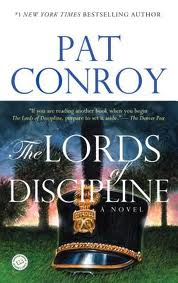
The major characters, in addiiton to the four room-mates, are the president of the college, the dean of students, the family of one of the boys in the room, and a love interest for the narrator. But the major character is Charleston itself, its foliage, its seasons, its smells, its beaches, its grass, its insects, its social conventions, its colonial origins, its Confederate past, its slave past, its caste system. As a book to read before visiting Charleston it is exactly right. (Though it did not tell me why that 1920s dance is called ‘Charleston.’)
What happens? The boys learn a lot and our protagonist grows up. The novel is rich with incident and offers a flavour of that all male environment where brutality taken and brutality given is the road to manhood. To list all of the examples would make it seem a litany of violence and blasphemy, and it is not. Though there is plenty of both.
Conroy alternates very deftly between the systematic beastiality of some events at the school with lyrical descriptions of the coastal wind, or tiered reflections on love and life by the boy becoming a man. Conroy’s judgment in measuring for the reader doses of pain with relief from it is sure. He guides the reader through the distasteful parts by providing oases before moving on.
Throughout the prose is beautiful, elegiac for lost youth.
None of the characters are cardboard. Even the president, a thinly disguised representation of Douglas MacArthur, and the many who imitated him, is developed. He has his reasons, convoluted and self-serving though they be, but they are not idiosyncratic or synthetic. He is not simply a plot device. The same goes for the Dean of Students, the Commandant. He is not honest but he is trying to do what is best.
Of course the most well developed character is the narrator who tells some of this in retrospect. His inner confusions, contradictions, volte faces, his mistakes, his blunders, are very touching as he recovers from romantic rejection, deals with social ostracism, copes with responsibilities shoved onto him, is rocked by betrayal, weighs the demands of friendship…. Life is complicated at any age but the more so for youth.
The other three room-mates are also developed personalities, though we see them only in relation to the narrator. The other cadets, even the sadists, are presented as human beings, despicable though some are, and not merely as plot devices. It is a great talent that can do that. Conroy seems to be in complete control and command of the novel; he is no child prodigy but a mature observer and a seasoned ponderer on the human comedy.
All of this is played out against the times in the United States in the 1960s. Civil rights and integration of this school, and the Vietnam War in which many of the graduates of the school have already served. But always more important than these externalities is the school itself and its very Charleston cosmology.
There is enough violence, profanity, stupidity, and prejudice in the book to interest a Hollywood film producer in turning it all into slam-bang cardboard. Read the book, skip the film is my advice.
Conroy has written much else, like The Great Santini, and I will read more some time. I also plan to re-read another book about a military school. It will be Calder Willingham’s End as a Man (1947). His most arresting character was not the victim but the vicious bully.
Having finished the book and before gathering my own thoughts I looked for reviews but all I could find were hundreds of comments on Good Reads and Amazon, and those I scanned were as inane as most comments on Trip Advisor. Most are about that fascinating subject, the writer of the comment, and not about the book. These are no doubt the same twits who FaceBook their every meal. I am sure there are measured and informative reviews available but they are overgrown with the obscuring and choking vines of the Twitterati. I am left to my own devices.
Herbert Hoover, A Presidential biography
Inspired by Robert Caro’s nonpareil biography of Lyndon Johnson, I have been reading biographies of US presidents as the occasion permits. Shortly after I decided to do that I chanced up Edmund Morris’s three volume biography of Teddy Roosevelt. Reading those three volumes confirmed me in the enterprise, though one volume works suffice. I have since read Willard Randall, George Washington; David McCulloch, John Adams; Walter Borneman, James Polk; and Stephen Ambrose, Eisenhower.
I noticed a review of a recent book about Herbert Hoover and since it was current and available I decided it would be the Hoover biography: Gary Dean BEST, The Life of Herbert Hoover, Keeper of the Torch, 1933-1964. It covers his post-presidential years, as part of multi-volume biography, where each volume is by a different writer. Despite the title there is much reference to Hoover as president.
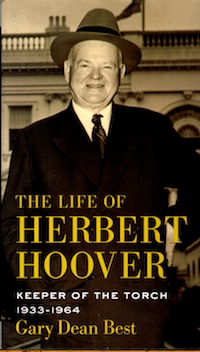
From the 550 pages of this book I conclude that Hoover had enormous energy and vitality and remained intellectually and political active into his 80s. He outlived many of his enemies, and all of his friends. That he was something of an intellectual, rather like T. R. Roosevelt. Hoover read a lot of books and wrote a few. He took care to do research for his many speeches and often packed them with facts and figures.
He also had a set of consistent beliefs about personal liberty that he often articulated and which informed much of this thought, action, and speech. It seems also that for all his public speaking, he was not easy with company, especially the hordes one meets at a convention. He often came, saw, spoke, and left by the side door.
In this period it was common for speeches to be reported nearly verbatim in newspapers, and often printed and distributed. They were also excerpted in newsreels shown in theatres. There was a constant demand for Hoover to speak and he did, except for the first year after leaving the White House, defeated by Franklin Roosevelt at the polls. The demand for Hoover to speak suggests that he struck a cord, as did the favorable press comment, and the audience reaction in theatres. It is too bad newsreels are gone from the silver screen because audience reactions in the darkened theatre was always uninhibited, as I recall.
I have no doubt that Herbert Hoover did much good in his life and that the reputation of his presidency has suffered in the shade cast by FDR. Having said that, in the period described in this book, Hoover appears all too often to be thin-skinned, pompous, and scheming. That he should appear thus in these pages is all the more surprising given that the author verges on hagiography in his adulation of every word, deed, and gesture Hoover made. The author is completely one-eyed. On that more at the end.
Hoover wanted to be president again, and like a lot of people who have wanted that job, he did not want to run for it, he just wanted it handed to him. So he made himself available for the Republican nomination in 1936 and again in 1940, and he opposed and undermined alternative candidates right up until the last minute. He offered mere lip-service support to the Republican nominees who emerged, Alf Landon and Wendell Wilkie, respectively. Yet he constantly felt they should pay obeisance to him, and when they did not, he withdrew further.
He spend thirty years vindicating his administration in those speeches with a mixtures of facts and figures that often made sense to him alone. He regarded every criticism of his administration as a personal slight, a smear. The author uses that word ‘smear‘ repeatedly for every objection or criticism levelled at any of Hoover’s many interjections into political life.
Hoover wanted to contribute, as World War II drew nearer, but only on his terms and in his way, and only if begged to do so. To that end he proposed some crazy ideas about food relief, and anyone who suggested his plan was not feasible or would, as it obviously would have, aided the German war effort is said, by the author, to have smeared Hoover.
Harry Truman tried to put Hoover to work and Hoover chaired several commission to streamline the Federal government. Well Truman thought the purpose was to streamline it but Hoover’s declared aim was to wind back Roosevelt’s New Deal, like the Tennessee Valley Authority, twenty years later. Despite Truman’s several efforts to flatter Hoover, it was never enough, and Hoover reveled in Joe McCarthy’s red baiting with nary a thought to conscience or consequence to judge by this book.
Even Eisenhower’s victory in 1952 left Hoover cold. Ike had other things on his mind and did not bow to Hoover, and so Hoover had few good words to say for him. I am afraid for most of the time in the period this book covers Hoover thought it was all about him. Petulant, one might say, for thirty years.
I have made several allusions to the book itself. There is no distance between the author and Hoover. If Hoover says black, then black it is. Assertions of fact are taken solely from Hoover, more than once. The book is packed with lengthy quotations from Hoover’s speeches and letters and these are transmitted without qualm or qualification and taken as read. Perhaps one page in four is such a direct quotation. The author seldom draws a conclusion from these long passages, but rather just lets them hang, often at the end of a paragraph. It becomes very tempting just to skip them since the author is not making any declared point with them.
For good or ill this is my Hoover biography.
Having acquired a taste for presidential libraries last year, I knew there was Hoover library and I just assumed that it was in Palo Alto where he lived most of his life. But one valuable fact I got from this book is that the Hoover Library, which Truman, demonstrating a magnanimity that Hoover never had, helped him achieve, is in West Branch, Iowa on I-80, which is where Hoover was born. It is a four-hour drive from Omaha through Des Moines, and I hope to visit it someday soon. It is near Amana.
Star Trek – Into Darkness
Good Trekkies that we have been since 1966, off we went to the Dendy Newtown last night to watch Start Trek: Into Darkness in 3D. Trekkies will have to see it. But many of them will be disappointed. Everything those who promote it say is true: it is high energy, it is fast and furious, it is action-packed, it has some etched characters…
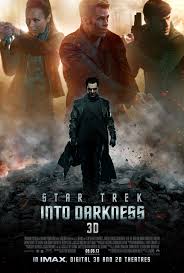
It is also true to say that it seems to have been created by writers with arrested development and targetted at twelve year old boys. No doubt that is a winning formula.
It is also true to say that it quite indistinguishable from three other movies currently showing in the Dendy chain: Man of Steel, Iron Man 3, and Escape from Planet Earth. It is loud, it is trivial, it is superficial, it is one-dimensional, thoughtless, inconsistent, with a leaky plot and inexplicable action and eighty (80) minutes of gratuitous violence… It lacks the gravitas of even a Marvel Comic.
What is worse, the local reviewers seem to think that it is an authentic representation of Star Trek and thus the reason there are Trekkies like us. WRONG!
Star Trek the Original Series featured more than one meeting where the assembled staff tried to think of ways to do things, debated over a table the limits of their orders, and then went away to think about it, because thinking takes time. In many episodes not a shot was fired or a punch thrown by the crew of the Enterprise.
Thinking time in Into the Darkness is 5-6 seconds. That is perhaps indicative of how decisions were also made about the film. Or is it the reality of Bush Junior White House?
Moreover, many episodes of Star Trek: Original Series posed questions about life and humanity from start to finish. I will cite only one example: The Devil in the Dark (Season 1, Episode 25 in March 1967). There are plenty of others from Original Series, Next Generation, Deep Space Nine, Voyager, and Enterprise, too. Of course, to cater to the television audience there is action, as well.
Into the Dark has many allusions to the Star Trek lore. The villain of the piece is Khan, played by Ricardo Montalban in ‘Space Seed.’ broadcast in February 16, 1967, and he reprised the role in the 1982 film. In 1967 the issue was returned soldiers. He was a great villain, as is Benedict Cumberbatch in this outing. That issue of returned soldiers remains relevant — Iraq and Afghanistan — but not when it is only an excuse for more fisticuffs.
This Captain Kirk is everything his mentor says he is, except for the potential for greatness. He is as arrogant, opinionated, and uninformed as a radio shock jock. Admittedly, he is far more handsome than any shock jock I have seen in the jungle.
There were certainly things for a Trekkie to like. The opening sequence is dazzling, albeit pointless. The Mr Spocks dialogue was delicious. And the actors were excellent at creating those familiars: Uhura, Chekov, Sulu, McCoy, Scottie, Spock, and Kirk, as well as Khan. They could do it, now if they had just had something interesting to do.
Diana Vreeland – Documentary
We watched this documentary about the redoubtable Diana Vreeland last night. Recomended for adults.
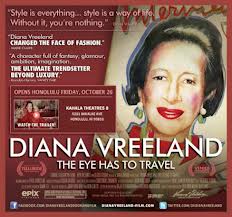
I knew nothing about Vreeland but thought the distaff side might be interested, so I borrowed it from the local Civic Video on spec. What I found was a force of nature who had no taste whatever but had drive, pride, intelligence, wit, and a capacity to learn. Her attitude seemed to be: be what you are. And strut it. She joined all of that to an enormous appetite for the world, realized through the no-expense-spared camera shoots she did for her magazines. All of this, in some measure, she passed on to those who looked at the editions of her magazines.
She was the long time editor of Harper’s Bazaar and then Vogue. She was one of the models for the demanding editor in ‘The Devil Wears Prada.’
In the boundless energy, enthusiasm, and bullying she reminded me of Lyndon Johnson. She was likewise as profligate.
Perhaps the most amusing part of the story is her last assignment at the Metropolitan Museum of Art where her shows, and shows they were, brought in masses of paying customers. Those successes condemned her in the eyes of the other curators, numbering her days there. It was easy to imagine meetings where curators argued that having people crowding into the Met was undesirable! I expect they did, though veiled and subtle in public.
http://www.dianavreeland-film.com
The return to Castlecrag
We went on a guided tour of Castlecrag over two and a half hours. Recommended to those with an interest in social history.
The walk was informative and interesting. It focussed on Walter Burley Griffin and Marion Mahony, and also those whom they influenced in the continued development of Castle Crag, as it was spelt in those days. We walked there once on a rainy day and saw some of the streetscapes and houses, thanks to the web site of the Walter Burley Griffith Society. http://www.griffinsociety.org/index.html
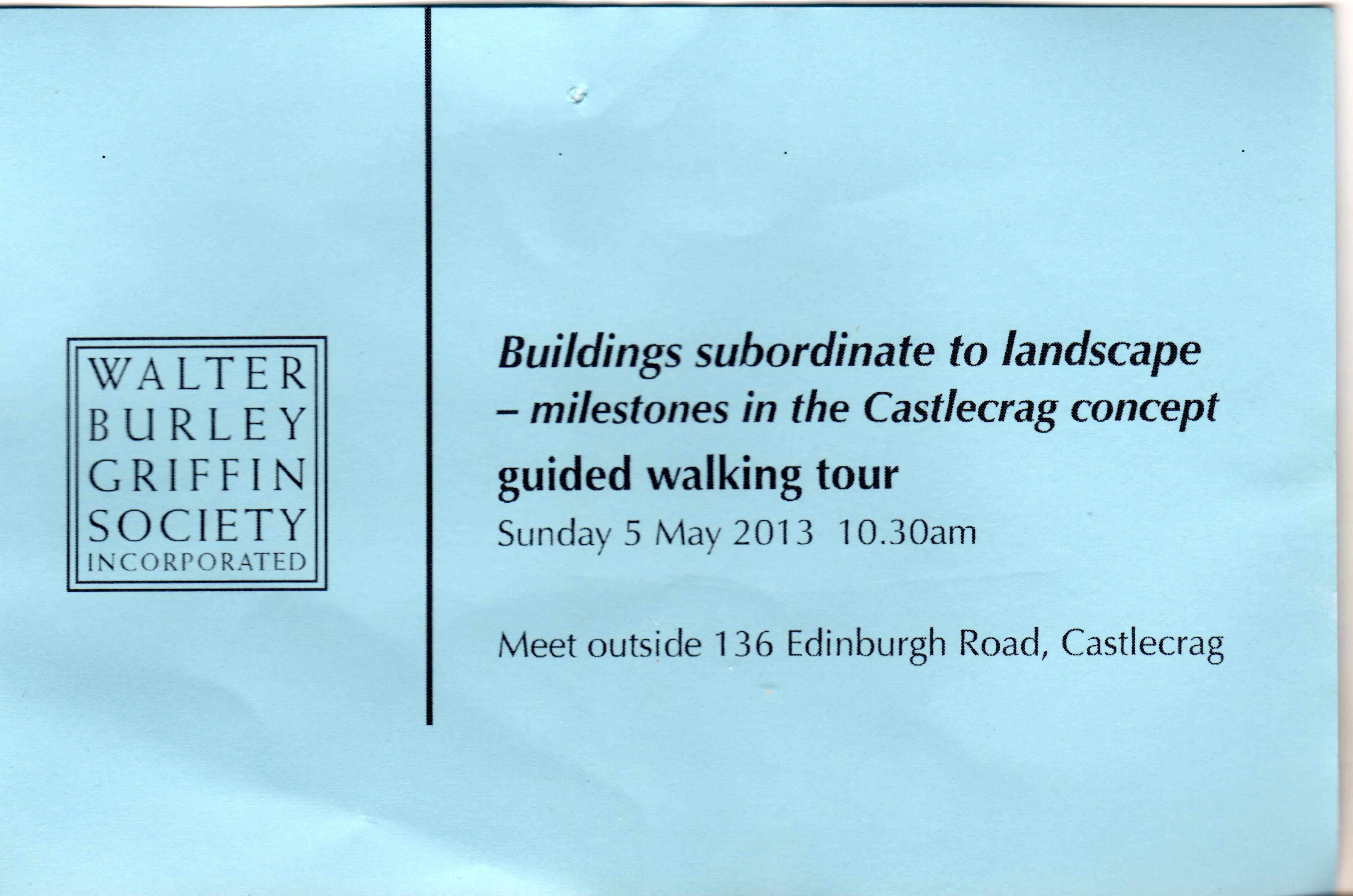
That gave us a familiarity, but this walk was more detailed. It filled in many details and emphasized the community-building parts of the plan. We had the choice of an arduous clamor down to the water and back or a more gentile walk, which we choose. It was the right choice for my knees though I did (barely) mange to ascend and descend Edinburgh Rock. It was a fine and crisp autumnal day and the guide was knowledgeable and informative.
The common areas reminded me a little of the playgrounds and common areas in the Daceyville. Though Daceyville was earlier and a creation of official state planning which began in 1912 and was converted into a project for returned soldiers after The Great War. It was the product of the scourge of creative types who peopled Castle Crag, it seems from the repeated and caustic way they are mentioned, bureaucrats. It did not subordinate buildings to the salt bush plain.
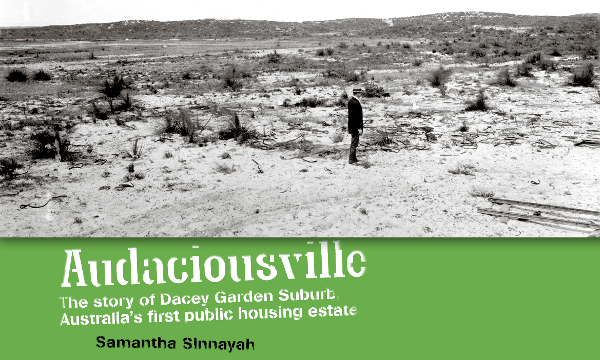
In contrast to Castle Crag, Daceyville was working class. The houses are conventional both within and without. But rather than rows of terrace houses they were spaced around rings with inner play grounds and parks. It was for dinky-die Australians who still felt themselves to be British. Indeed the overall look of Daceyville is English.
For more see Audaciousville
http://swft.cobb.ent.sirsidynix.net.au/client/cobb/search/asset/164268?rm=DOCUMENT+ARCHI0%7C%7C%7C1%7C%7C%7C2%7C%7C%7Ctrue
Thanks to tax dollars, a free download.
In contrast, we we were reminded on our walk, Castle Crag, planned and partly built by two ex-patriot Americans attracted Chinese and European investors and residents. The Chinese came from Melbourne, while the Europeans fled Naziism. Its early residents, which were too few to make the project financially viable, were often self-styled Bohemians: artists, poets, and other dreamers, who also could never pay top pound for the Griffin-Mahony creations.
I heard it said that aboriginals were leaving on the point at Castle Crag when Griffin and Mahony came but there is nothing about that in the material.
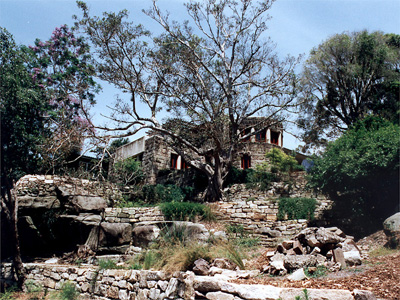
Both Daceyville and Castle Crag seem to follow a line from the Garden City movement in England which was in turn was informed by William Morris’s News from Nowhere. For Griffith and Mahoney that line ran through Frank Lloyd Wright. For Daceyville it was directly inspired by Ebenezer Howard’s Letchworth, the first of the Garden Cities in England just outside London. When Howard failed to make a living in Lincoln Nebraska, Howard returned to England and in time he turned to town planning.
Aside, we have seen many references to the fact that in latter in life, after Walter had died, Mahony went back over some of the drawings done in his name and blacked it out. She never explained, so the slather (what is a slather?) is open. The feminists declare that she was reclaiming her own work that the dastardly Griffin had appropriated. The grey Marxists claim she was reclaiming her own work that the evils of capitalism had forced her to disown, and so on. The ideologues always find what they want to find. As predictable as a late bus.
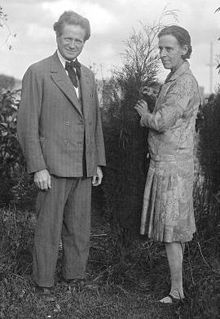
How about this: she was mad at him for dying and leaving her alone. Everything we know, everything the above interpreters reluctantly admit, is that the two were nearly one in everything they did, though not given to spouting off about it. Then he went and died and left her alone, half. No wonder she was angry, which psychology bores will tell us is part of grief. No ideological mileage in that but maybe some truth, something that seldom interests either ideologues or journalists.
A Year of Junk Mail
I groused about the junk mail filling up the letter box at Ack-comedy so much that I decided to do something about it. I put one sticker on the mail box banning junk mail and when that seemed to do no good, I added a second larger one that appealed to the Green conscience.
The second sticker did not seem to have any effect either, though there is one honourable exception mentioned at the end.
In the absence of riding shot gun on the letter box, I decided to compile a year’s worth of junk mail from ANZAC day 2012 to ANZAC day 2013. Bear in mind that the building alone has 42 letter boxes so everything I received is a fraction of the total in this building let alone the surrounding streets. Since we live around the corner I dealt with a repeat of the same items at home where they went directly from the letter box to the council recycling bin, usually without going in the front door.
But to return to the description, here is what I found. The pile measures 10 centimeters in height.

It contained 241 separate pieces and weighed 1.935 kilograms. A propos of the context, multiply that number of 241 by 42 and conclude that 10,122 items of junk mail were delivered to 1 Linthorpe Street or 84 kilograms of dead weight.
The items fell into a few categories. Real estate; restaurants, food, and drink; government and politics; and miscellaneous. To review each in turn, real estate contributed 52 pieces of which I could reuse 3 in my personal recycling effort, that is, print on the blank back side. They varied from handsome cards to 256-colour brochures and flyers. I responded to none of them. The effort and cost of design, printing, and distribution was wasted in its entirety as is the effort of recipients in disposing of it, the council in paying for it to be collected and trucked to a recycling centre….
The restaurants ran to 70 items. Many were from pizza places usually emphasizing delivery. None came from the restaurants we frequent on King Street, I am happy to say. I am unhappy to say that 24 pieces, more than a third of restaurant items and a tenth of the total of all items came from a single noodle bar on King Street. With dogged persistence these 24 items were each very plain and all identical. No colour, no flair, but repetition and more repetition. I have sworn never to eat there and to tell others not to do so either. It seems to be my only form of reciprocity. Yes, I thought about going it and asking to be excluded but apart from cementing my reputation as a nutter, I could not imagine that accomplishing anything.
I thought about inserting some photographs of offending items but decided against it as that would only give them more exposure.
Another stack was a newsprint item call the Inner City Weekender. Never having opened one, I have no idea of its contents, but I suspect much advertising for real estate and restaurants.
Then there is the government and politics pile, numbering 33. This pile included many notices about works on the roads and nearby rail line. Others were notices from the City Sydney Council about waste removal and recycling. Then there were others that were, let us say, community building notices, inevitably featuring local councilors or the Mayor. I will accept these as necessary. I was able to recycle 6 of the items for printing.
During this period there was one local election for the City of Sydney. A dozen or so items were letter drops by office-seekers, known as rent-seekers in economics.
Finally, we come to miscellaneous of 85 items. Most of these came from small businesses offering services from carpentry, to foot reflexology, house cleaning, dog walking, and the like. These are all very small businesses.
There was also a drop from a retirement home in distant Lane Cove, and however distant Lane Cove is in kilometers, in ambience it is an alien world compared to Newtown. There was also a drop from one giant corporation, Telecom. Yes, I know that in order to distance itself from its own incompetent past it changed its name to Telstra, to usher in a new era of incompetence. But under the make-up it is Telecom unalloyed.
A quick look at Google is depressing. There are online ads, several, to recruit junk mail walkers all over Sydney. And an even more depressing is a news item that claimed junk mail did work. I suppose one hit in a thousand pays for it.
Technical matter for nerds.
The Ack-comedy is the private office I use in a nearby apartment building.
Junk mail is material in the letter box that is not addressed by name. See the Wikipedia entry: http://en.wikipedia.org/wiki/Advertising_mail
I excluded post addressed to previous occupants, which I dutifully mark Unknown at this Address and Return to Sender and drop in the slot at the Newtown Post Office. [I have printed Avery labels to affix to such returned mail.] I also excluded mail addressed to me, though there is little of that these days.
I have excluded from this account the largest single item. The Inner West Courier which is dropped on the mail boxes porch, a pile of 30 or so wrapped in plastic. It remains there four or five days until the building attendant dumps them in the trash. Maybe I should borrow one such pile for a weigh in and count. Since it is never in my letter box I left it out for the moment.
Nor did I emphasize the mess these unwanted items lead to on the porch. Though there is a disposal basket left there for such detritus some dwellers cannot seem to hit it, so many items are on the floor, left there for others to pick up. Maybe I should photograph that, too.
One honourable exception: The Mitre 10 drops are occasionally to be seen hanging out of other boxes but not from mine after the second sticker. Clearly the dropper takes note of the signs and excludes some. Thank you Mitre 10. There may be others who also exercised a like discretion but I did not detect them. The Mitre 10 examples shows that the others could do so, as well. Thus they act knowingly and culpably.
Murray Bail, Eucalyptus (2009)
Murray Bail, Eucalyptus (2009)
Recommended for adults.
A delightful fairy tale for grown-ups from a master of the short story. This, however, is a novel in length and conception, but it is also a book of short stories. That distinctive combination is part of its charm, and charming it most certainly is. The princess is in the tower amid a forest of eucalypts and her suitors must prove themselves worthy of her. Sound familiar?

Mr. Holland’s wife died in childbirth and he the baby girl with an insurance payout retired to the hinterland where he planted every known and some unknown eucalypts without end. There was no grand plan and yet a pattern emerged. See above. Then along came, first, the professor, and, then, the sign maker and – in time – there came a revelation.
Wonderful. It deserves the superlatives applied to it.
I have been asked the meaning of ‘adults’ in my recommendation. That is a question on notice.
